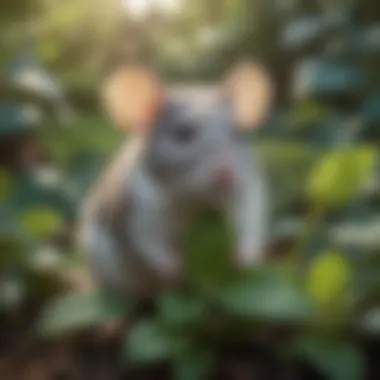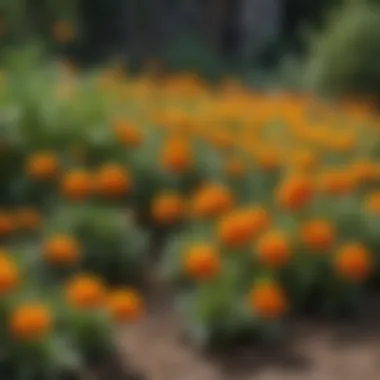Plants That Repel Mice: Natural Deterrents Explained


Intro
The struggle against pest rodents, particularly mice, is a challenge many households and communities face. The search for effective, environmentally friendly solutions has led to renewed interest in utilizing plants with natural repelling properties. This article delves into specific plants that are known to deter mice, examining their ecological significance and practical application in everyday settings. By understanding how these plants work, individuals can adopt a more sustainable approach to pest control, aligning with both their practical needs and environmental concerns.
Animal Overview
Common Name and Scientific Classification
Mice can refer to various species within the family Muridae, with the most common being the house mouse (Mus musculus). These creatures are small, adaptable rodents often found in close proximity to human dwellings. Their ability to reproduce rapidly contributes to their status as pests in many areas.
Physical Characteristics
House mice typically measure 2.5 to 4 inches in length, excluding their tails. They possess small eyes, rounded ears, and a long, thin tail. Their fur is usually gray or light brown, which aids in camouflage.
Habitat and Distribution
Mice enjoy environments that provide ample food and shelter. They thrive in urban areas, fields, and gardens, often nesting in walls or underground burrows. Their distribution spans across global regions, making them a ubiquitous problem in both rural and urban settings.
Important Plants for Deterrence
Certain plants are noted for their ability to repel mice effectively. Here are some of the most commonly referenced varieties:
- Peppermint (Mentha × piperita): Known for its strong scent, peppermint oil is a natural repellent.
- Lavender (Lavandula spp.): The fragrance of lavender is often off-putting to mice and many other pests.
- Rosemary (Salvia rosmarinus): This perennial herb can deter mice while also offering culinary benefits.
- Sage (Salvia officinalis): Another herb that mice tend to avoid due to its strong aroma.
- Catnip (Nepeta cataria): Interestingly, while beloved by felines, mice avoid areas where catnip is present.
“Utilizing plants for pest control not only promotes sustainability but also enriches the surrounding ecological environment.”
Practical Applications
In order for these plants to be effective as mouse repellents, they can be deployed in several ways:
- Planting Around Homes: Strategically placing these plants around the perimeter of a home can help create a natural barrier against mice.
- Essential Oils: Extracting oils from these plants can enhance their repelling effects. Spraying diluted peppermint oil in critical areas may yield positive results.
- Potted Herbs Indoors: Keeping pots of these herbs indoors can mitigate the chance of mice entering the space.
End
Understanding the role of specific plants in repelling mice is an integral part of developing effective pest management strategies. These plants not only serve as natural deterrents but also contribute positively to the ecosystem. Adopting such methods can provide families and communities with a sustainable solution to the issues of mice infestations.
Preamble to Mice and Their Habitats
Understanding the habitats of mice and their behavior is crucial in formulating effective strategies for natural pest control. This section delves into the intricate relationship between mice and their environments. It highlights the ecological significance of these rodents and how their presence can impact human living conditions.
Understanding Mouse Behavior
Mice are curious and adaptable creatures, exhibiting behaviors that can significantly affect their interactions with humans. They are primarily nocturnal and tend to browse for food during the night. Their ability to squeeze through small spaces allows them to explore various environments.
One particular behavior of note is their tendency to hoard food. This habit not only helps them survive in the wild but also leads them to invade homes in search of sustenance. Understanding this behavior can help in developing more effective deterrent strategies, particularly those involving plants that naturally repel them.
Additionally, mice communicate through vocalizations and pheromones, using scent to navigate their surroundings and to mark territory. This information can be invaluable when employing natural deterrents, as some plant types disrupt these communication methods, making areas less attractive to mice.
Common Habitats of Mice
Mice can thrive in a variety of habitats, allowing them to adapt to different ecosystems. They are commonly found in:
- Urban areas, where they exploit human structures for shelter and food.
- Agricultural settings, taking advantage of crop yields.
- Woodland and grassland regions, where they build nests in underbrush and burrows.
The presence of certain plant species can influence mouse populations in these areas. For instance, gardens with attractive vegetation may draw mice looking for food. In contrast, areas populated with repelling plants can serve as effective barriers against these pests.
Ultimately, understanding where mice live and their behaviors is vital in harnessing the power of botanical deterrents to achieve effective pest management.


The Importance of Natural Deterrents
The exploration of natural deterrents against mice touches on several significant factors involving ecological balance and health. In an age where environmental sustainability is paramount, understanding the role of plants in pest management is critical. Mice are not just a nuisance; they can be harmful by spreading diseases and damaging property. Consequently, employing natural solutions not only helps in maintaining a pest-free environment but also aligns with the broader goals of ecological responsibility.
Natural deterrents present an alternative means of addressing pest issues without resorting to harsh chemicals. Many families, especially those with pets or young children, prefer to avoid chemical repellents that can pose health risks. Plant-based solutions are less likely to lead to adverse health effects and offer a more conscientious approach to pest control.
Furthermore, incorporating natural deterrents like specific plants creates a more balanced ecosystem. Unlike artificial repellents that can detrimentally affect beneficial species, plants intended to repel mice contribute positively to the local environment. This strategic selection promotes biodiversity while also safeguarding homes and gardens from rodent intrusions.
Environmental Considerations
When considering methods to repel mice, one must understand the impact on the environment. Chemical repellents often contain synthetic compounds that can leach into the soil and water systems. These substances may disrupt local flora and fauna, lead to water pollution, and ultimately harm ecosystems.
On the other hand, plants that repel mice are less invasive. They tend to attract beneficial insects, like pollinators, which enhance the overall health of the garden or yard.
For gardens, integrating repellent plants fosters a more resilient ecosystem. Certain plants can improve soil quality, thus benefiting even the plants that attract pests. This cultivation of harmony in nature is fundamental to sustainable practices.
Health Implications of Chemical Repellents
The health implications of using chemical repellents warrant careful consideration. Various chemical formulas are effective at repelling pests, but they often come with hidden dangers. Many people are unaware that exposure to these substances can lead to respiratory issues, skin irritations, or even more profound long-term health problems. For households, particularly those with children or pets, the risks can be unacceptable.
Using plants as deterrents offers a safer alternative. For instance, the essential oils in mint, lavender, and rosemary provide an unpleasant scent for mice without posing threats to human health. Homeowners can cultivate these plants with confidence that they will not introduce harmful chemicals into their living space.
Botanical Overview of Deterrent Plants
Understanding the role of various plants in repelling mice is essential for developing effective pest control measures. This section explores the botanical background of plants that act as natural deterrents. By focusing on specific plant families and the active compounds they contain, readers can appreciate the intricacies of how certain flora can serve a purpose beyond their aesthetic value.
Plant Families Known for Repelling Mice
Several plant families have demonstrated an ability to repel mice through their scent or other properties. Notably, plants from the following families are particularly effective:
- Lamiaceae (Mint Family): This family includes peppermints, spearmints, and other mint varieties. The strong aroma is unappealing to mice.
- Asteraceae (Daisy Family): Marigolds, recognized for their vibrant colors, also emit scents that deter mice.
- Rutaceae (Rue Family): Rue possesses a distinctive odor that is often offensive to rodents.
These families share common characteristics that enhance their capability as pest repellents. Their aromatic compounds and chemical constituents often create an environment that is less attractive to mice. Consequently, incorporating these plants into your garden can serve as a dual-purpose strategy—beautifying your space while providing a natural defense.
Active Compounds in Repellent Plants
Active compounds within certain plants contribute significantly to their ability to repel mice. These compounds can vary widely among species but are generally categorized as follows:
- Essential Oils: Components such as menthol in mint and limonene in citrus plants have shown efficacy in keeping mice at bay. These oils are often volatile, which means they disperse into the air and create a potent barrier against pests.
- Tannins and Flavonoids: Found in various plants like sage, these compounds provide not only flavor but also deter pests due to their unpalatable taste or smell.
Understanding these active compounds informs gardeners and pest management experts about which plants might work best in various scenarios.
Plant choices should focus not only on aesthetics but also on their functional benefits in controlling pests. Selecting the right plants based on their families and active compounds can improve the health of both gardens and homes.
Key Plants That Repel Mice
Understanding the role of certain plants in repelling mice is crucial for developing natural pest control strategies. These plants not only serve to deter mice effectively but also contribute positively to the environment. By incorporating these botanicals into gardens or home spaces, individuals can foster an ecosystem that discourages rodent presence while enhancing the beauty and utility of their surroundings.
Mint Varieties
Mint is a well-known repellent for various pests, including mice. The strong scent emitted from mint leaves confuses their olfactory senses, making areas planted with mint less attractive to them. There are several varieties, but peppermint and spearmint are particularly effective. Planting these varieties can create a natural barrier around gardens or essential entry points in homes. Regular trimming of mint plants keeps them healthy and potent for repelling mice.
Growing Conditions
Mint thrives in moderately fertile soil and requires consistent moisture. Its vigorous growth means it can rapidly spread, so consider using containers if space is limited.
Lavender
Lavender has a pleasant scent for humans but serves as a strong deterrent for mice. The aromatic oils in lavender are off-putting to these rodents. Placing lavender plants near windows, doors, or other entries can potentially reduce the likelihood of mice accessing your space. Furthermore, lavender attracts beneficial insects, adding another layer of ecological balance to your garden.


Maintenance Tips
Lavender prefers well-drained soil and can tolerate drought conditions. Regular pruning promotes new growth and vitality, maintaining its mouse-repellent properties.
Eucalyptus
Eucalyptus trees are renowned for their aromatic leaves, which also act as a deterrent against mice. The strong scent can mask food odors, which might otherwise attract them. Using eucalyptus oil or the leaves in strategic locations around your home can enhance your mouse-repelling efforts.
Environmental Considerations
While eucalyptus is an excellent choice for larger gardens, its fast growth may require regular management to prevent overcrowding and maintain the health of nearby plants.
Marigolds
Marigolds not only beautify gardens but also impart a strong odor that is unpleasant to mice. Their bright flowers can brighten up a space while providing pest deterrence simultaneously.
Planting Strategy
These flowers thrive in sunny locations and well-drained soil. Planting marigolds in a border around gardens can offer visual appeal and natural pest control.
Sage
Sage is another herb that can repel mice, primarily due to its pungent aroma. Its flavor is appreciated in culinary uses, which can make it a dual-purpose plant in your garden.
Care Instructions
Sage needs full sunlight and prefers sandy or well-drained soil. Trim the plant regularly to encourage growth and to keep its aroma potent.
Rosemary
Rosemary can deter various pests, including mice. Its woody aroma can disrupt the smells that attract rodents, making it an effective repellant. This resilient herb can also serve culinary purposes and attract beneficial pollinators.
Growth Recommendations
Rosemary prefers dry, well-drained soil and requires full sunlight. Regular pruning helps maintain its shape and maximizes its repelling effectiveness.
In summary, incorporating plants such as mint, lavender, eucalyptus, marigolds, sage, and rosemary can create a proactive approach to keeping mice away from your living space. Each plant not only deter pests but can also be integrated into a beautiful and functional garden design.
Planting and Maintenance Practices
Planting and maintaining plants that repel mice is crucial for several reasons. First, the right practices amplify the effectiveness of these plants. Careful selection of the location, appropriate soil conditions, and diligent maintenance can create an environment where these plants thrive. This not only enhances their repelling properties but also contributes to overall ecosystem health. Moreover, understanding these practices helps in using these plants as a reliable pest management strategy in gardens and homes.
Choosing the Right Location
Selecting the proper location for planting deterring plants is fundamental. Different plants have distinct light and space requirements. For instance, mint prefers partial shade whereas lavender requires full sun. Therefore, knowing these preferences ensures optimal growth and effectiveness in repelling mice.
Furthermore, it is essential to plant these species away from entry points of home or garden. Mice are less likely to venture into areas that are surrounded by strong-smelling plants.
- Consider the Microclimate: Assess sunlight, wind, and moisture.
- Accessibility: Place them where they can be easily cared for.
- Spacing: Ensure enough individual space for each plant to avoid competition.
Soil and Water Requirements
Soil and water play a critical role in the health of the plants that repel mice. Good drainage is important, as most of these plants do not tolerate soggy soil. Clayey or compacted soils may require amendments to improve drainage. The ideal soil for eucalyptus, for example, is well-drained and sandy.
Watering practices also differ. Overwatering can lead to root rot, while under-watering can stress plants, reducing their repelling effect. A consistent watering schedule, particularly during dry spells, supports robust growth. Here are some tips:
- Use Mulch: This conserves moisture and suppresses weeds.
- Check Soil Moisture: A simple finger check can help maintain balance.
- Fertilization: Use organic fertilizers to promote healthy plant growth.
Companion Planting Strategies


Companion planting is a strategic way to enhance the effectiveness of plants that repel mice. Certain plants can complement each other not only in terms of pest deterrence but also in growth support. For instance, pairing rosemary with sage can create a combined aroma that may deter not just mice, but several other pests as well.
Furthermore, establishing a diverse garden can increase the ecological balance and resilience against pests. Here are some strategies:
- Mixing Aromatic Plants: Consider blending multiple repelling varieties.
- Intercropping: Plant alternating rows to disrupt pest pathways.
- Utilizing Natural Repellents: Enhance plants' potency with barriers or companion herbs like dill or basil.
The integration of plant-based strategies not only helps in pest management but also contributes to a richer biodiversity in gardens.
Integration of Plants in Pest Management
The integration of plants in pest management is a crucial aspect of developing sustainable strategies for controlling mice populations. In an ecosystem, balance is key. Utilizing plants to naturally deter pests like mice offers multiple benefits. Firstly, these plants contribute to biodiversity. They provide habitats for beneficial insects while restoring the ecosystem's equilibrium. A garden or yard filled with diverse flora can also reduce the likelihood of a pest outbreak, as it supports natural predators that keep mouse populations in check.
Moreover, planting strategies can minimize reliance on chemical pesticides. Many families today prioritize environmentally safe alternatives to synthetic chemical deterrents, which can have adverse effects on health and the environment. Using plants such as mint and lavender promotes a healthier living space while creating barriers against pests. Additionally, these plants can improve air quality and offer aesthetic value to home gardens, making them an excellent addition to urban and suburban settings.
However, effective integration requires careful planning. Selecting the right plants involves understanding both the mouse behavior and the particular environment. Some plants may thrive in certain climates or soil types but fail to flourish elsewhere. Hence, proper research before planting is essential. This consideration leads to a longer-lasting effect against pest intrusion.
Incorporating plants in pest management not only enhances the garden's appeal but also strengthens the local ecosystem.
Another important factor is companion planting. This technique involves growing specific plants together to maximize pest control. The chemical compounds released by certain plants can act in unison. For example, combining mint with other strong-smelling plants creates a more potent barrier. Such practices lead to a holistic pest management approach that benefits both gardens and their natural inhabitants.
In summary, integrating plants into pest management provides a multidimensional strategy. It supports environmental health, reduces dependency on chemicals, and promotes a diverse ecosystem. Careful selection and combination of plants can yield substantial benefits while fostering a resilient garden that naturally deters mice and other pests.
Creating a Pest-Resistant Garden
Creating a pest-resistant garden is not only about planting deterrents. It requires an understanding of garden ecology. The foundation of a pest-resistant garden begins with healthy soil. The better the soil health, the stronger the plants will be, making them less susceptible to pest threats, including mice. Enriching the soil with organic matter can enhance its health over time.
Choosing the right plants is also essential. Native plants tend to be more resilient. They are already adapted to local climates and pests. Establishing a garden with a focus on native species can minimize pest difficulty. As such, researchers recommend including a mix of perennials, which will provide long-lasting greenery, and annuals for seasonal variety.
Furthermore, proper garden layout plays a role in keeping pests at bay. Some guidance includes:
- Planting in clusters: Grouping plants together can create a stronger scent, confusing mice.
- Using barriers: Physical obstacles like fencing can deter rodents from entering the garden area.
- Incorporating diverse heights: A multilayered garden with tall plants, short plants, and ground covers can disrupt mouse pathways.
Paying attention to watering and feeding practices is also important to improve durability. Excess water can attract pests, so watering should be done wisely. Also, using natural fertilizers can reduce the risk of chemical residues that may harm beneficial insects responsible for pest control.
Gradually, these practices can cultivate a robust ecosystem. This results in a self-sustaining garden, naturally supportive of both its inhabitants and the surrounding wildlife.
Combining Plants with Other Deterrents
Combining plants with other pest deterrents provides a comprehensive approach to managing mice issues. While specific plants have repellent properties, their effectiveness can significantly increase when paired with non-plant based methods. A synergistic approach can yield a more effective solution.
For instance, integrating mechanical traps within a plant-rich environment can prove beneficial. Using traps strategically placed around areas populated with repellent plants ensures that the deterrent effects are enhanced with physical measures. This dual strategy can simultaneously dissuade mice from entering and capture those that may already be present.
In addition, natural essential oils extracted from plants can serve as powerful repellents. Oils such as peppermint or eucalyptus can complement the botanical deterrents, offering concentrated and heightened effects. Utilizing these oils in diluted sprays can maintain a barrier while also providing a fresh scent. Regular application can maintain their effectiveness over time.
Finally, community practices should not be overlooked. Collaborating with neighbors to adopt similar strategies can create a more resistant neighborhood. Shared resources like bulk planting damage from pests or joint education campaigns about best practices can form a stronger defense against mouse populations.
Culmination
The use of plants as a natural deterrent to mice is a significant topic that deserves attention. This article highlights both the effectiveness and practical benefits of utilizing botanical solutions in pest control. Plant-based deterrents offer an environmentally friendly approach, reducing reliance on chemical pesticides that can have detrimental effects on human health and ecosystems. Moreover, these plants can enhance the aesthetic appeal of gardens and homes, providing dual benefits.
Summarizing the Benefits of Plant-Based Deterrents
Plant-based deterrents present several advantages:
- Safety: Unlike chemical repellents, many plants pose little to no risk to children or pets.
- Sustainability: Using plants aligns with eco-friendly practices, promoting biodiversity and encouraging a balanced ecosystem.
- Cost-effectiveness: Once established, these plants require minimal investment, particularly when propagated from seeds or cuttings.
- Multi-purpose usage: Many of the plants discussed in this article, like lavender and rosemary, not only repel mice but can also serve culinary or aromatic purposes.
Understanding these benefits can guide families, gardeners, and wildlife biologists in making informed decisions about pest management.
Future Directions in Natural Pest Control
As interest in sustainable practices grows, the importance of research into natural pest control methods increases. Future efforts should aim to:
- Explore the compatibility of plant varieties with various regional ecosystems to enhance effectiveness.
- Investigate the synergistic effects of combining multiple plant species to create a robust deterrent environment.
- Emphasize community education on integrating plants into existing pest management frameworks, promoting a holistic understanding of pest control.
By redirecting focus to natural solutions, stakeholders can contribute to the development of more effective strategies for controlling mouse populations without compromising ecological integrity. It is essential to keep pursuing studies in the field of botany and pest management to deepen our understanding and build stronger defenses against unwanted pests.







